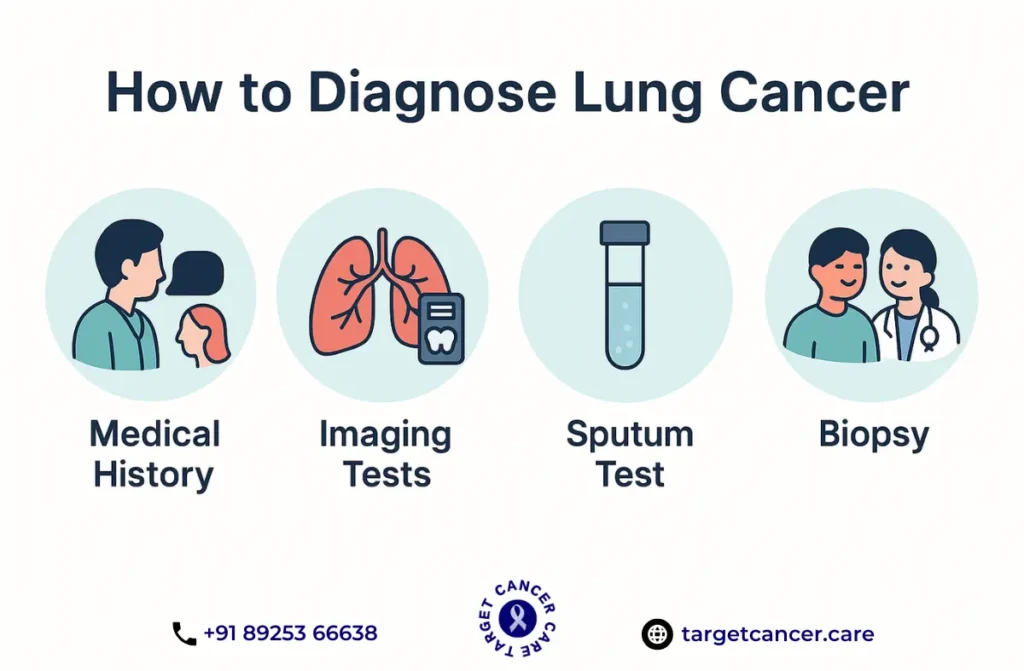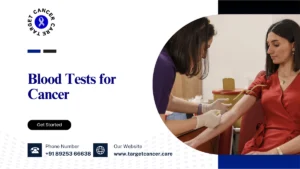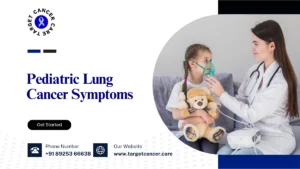Lung cancer is one of the most serious and common forms of cancer worldwide, affecting millions of people every year. Understanding How is lung cancer diagnosed is crucial for early detection and effective treatment. The earlier lung cancer is identified, the more successful the treatment outcomes can be. If you’re concerned about lung cancer, knowing the diagnostic steps can help you navigate the journey with greater clarity and peace of mind.
How is Lung Cancer Diagnosed?
Lung cancer diagnosis involves a combination of imaging studies, laboratory evaluations, and invasive procedures. Understanding how is lung cancer diagnosed requires exploring the symptoms, risk factors, and a range of diagnostic tools to confirm the presence and type of lung cancer.
Doctors typically begin the diagnostic process when a patient presents with persistent cough, chest pain, or unexplained weight loss, especially in individuals with a history of smoking or occupational exposure to carcinogens. The question of how is lung cancer usually detected? is answered by a comprehensive approach involving imaging, lab tests, and biopsies.
Often, lung cancer is discovered during imaging for unrelated conditions, especially in early stages when symptoms are minimal. That is why emphasizing how to detect lung cancer early is crucial in improving outcomes.
How Do Doctors Check for Lung Cancer?
Doctors use a step-by-step diagnostic approach to determine if a patient has lung cancer. Here’s how they proceed:
- Medical History & Physical Examination: Physicians ask about symptoms like chronic cough, shortness of breath, chest discomfort, or hemoptysis. They also evaluate family history, smoking habits, occupational exposures (like asbestos), and history of chronic lung conditions.
- Risk Factor Evaluation: Age, exposure to radon gas, family history, and long-term tobacco use play a major role in the assessment. Individuals with these risk factors are more likely to undergo further diagnostic testing.
- Initial Imaging: If suspicion arises, the doctor orders imaging tests to check for abnormal growths in the lungs. This begins the pathway toward establishing the diagnosis of lung cancer.
- Diagnostic Confirmation: Abnormal imaging findings lead to tissue sampling via biopsy. This confirms the presence of malignant cells and helps determine the cancer type and stage.
Knowing how is lung cancer diagnosed equips patients with insight into the layered and detailed process used by specialists.

Imaging Tests Used to Diagnose Lung Cancer
Accurate imaging is critical in how to detect lung cancer early and define its extent. Here are the primary imaging tools used:
- Chest X-ray: This is usually the first imaging test. It can reveal large tumors, collapsed lungs, or fluid in the pleural space. However, smaller tumors may go unnoticed, making further testing necessary.
- Computed Tomography (CT) Scan: A CT scan offers a more detailed cross-sectional image of the lungs. It helps identify small nodules and determine if cancer has spread to lymph nodes or other organs. This scan plays a pivotal role in how is lung cancer diagnosed in both suspected and routine evaluations.
- Magnetic Resonance Imaging (MRI) Scan: Though less commonly used than CT, MRI is essential for detecting if cancer has spread to the brain or spinal cord. It offers superior soft tissue contrast, making it valuable in certain staging scenarios.
- Positron Emission Tomography (PET) Scan: PET scans highlight areas of high metabolic activity, often correlating with cancer growth. Combined with a CT scan, a PET-CT helps determine the spread of disease and is essential for establishing the diagnosis of lung cancer and staging.
These imaging modalities are central to answering the question: How is lung cancer usually detected?
Laboratory Tests Used for Diagnosing Lung Cancer
Laboratory evaluations complement imaging findings and support tissue diagnosis.
- Blood Tests: While blood tests cannot confirm lung cancer, they help assess overall health and organ function. Markers like complete blood count, liver function, and kidney profile guide treatment decisions once a diagnosis is made.
- Sputum Cytology: Patients with persistent coughing may provide a sputum sample for cytological examination. Microscopic analysis of mucus can reveal cancerous cells, especially in centrally located tumors like squamous cell carcinoma. It serves as a non-invasive first-line test in how is lung cancer diagnosed, particularly when imaging is inconclusive.
These tests are part of a broader diagnostic toolkit that helps narrow down the diagnosis while planning definitive procedures.
Procedures Used for Diagnosing Lung Cancer
When imaging and lab tests suggest malignancy, doctors proceed with procedures to retrieve tissue samples and confirm cancer.
- Needle Biopsy: A fine needle or core needle is guided through the chest wall into the lung mass, usually with CT guidance. It provides tissue for histopathological analysis. This method is minimally invasive and often used when lesions are peripheral.
- Bronchoscopy: A flexible scope is inserted through the nose or mouth into the airways, allowing direct visualization and biopsy of tumors within central bronchi. Bronchoscopy is integral to how is lung cancer diagnosed when the lesion is near large airways.
- Endobronchial Ultrasound (EBUS): EBUS combines bronchoscopy with ultrasound to visualize lymph nodes and surrounding structures. It enables targeted biopsies of lymph nodes in the chest, which is essential for staging and how is lung cancer treated effectively.
- Thoracentesis: If fluid is present in the pleural space, a sample is withdrawn using a needle. The fluid is examined for malignant cells. This helps confirm pleural involvement and informs staging.
- Thoracotomy: In complex cases, an open surgical procedure may be required to obtain a diagnostic sample. Though invasive, it provides a comprehensive look at the tumor and surrounding tissues, guiding aggressive treatment decisions.
Each of these procedures is critical in establishing the diagnosis of lung cancer, ensuring the most accurate and timely management.
12 Conditions Often Mistaken for Lung Cancer
Lung cancer symptoms can mimic many other respiratory or systemic diseases. Awareness of these conditions is important for differential diagnosis.
- Tuberculosis: Both diseases can cause chronic cough, night sweats, and weight loss. Imaging may show nodules or cavitations, leading to misdiagnosis.
- Pneumonia: Infections can present with fever, cough, and lung infiltrates on X-rays. Tumors can cause post-obstructive pneumonia, confusing the clinical picture.
- Chronic Obstructive Pulmonary Disease (COPD): COPD causes coughing, wheezing, and breathlessness. The overlap in symptoms can delay recognition of a coexisting tumor.
- Pulmonary Embolism: Sudden chest pain and shortness of breath may mimic lung cancer spread. CT angiograms differentiate embolism from malignancy.
- Lung Abscess: Abscesses can appear as cavitary lesions similar to necrotic tumors on scans. Proper microbiological testing helps distinguish the two.
- Sarcoidosis: This inflammatory disease leads to lymphadenopathy and lung nodules. Biopsy is often necessary to exclude malignancy.
- Pulmonary Fibrosis: Fibrotic changes may obscure or mimic tumors on CT scans, complicating how to detect lung cancer early.
- Asbestosis: Individuals exposed to asbestos may develop pleural plaques and fibrosis, which mimic mesothelioma or other lung cancers.
- Fungal Infections: Histoplasmosis or aspergillosis can form lung nodules, often mistaken for neoplasms on imaging.
- Bronchiectasis: Chronic airway inflammation can cause hemoptysis and recurring infections, overlapping with cancer symptoms.
- Rheumatoid Lung Disease: Patients with autoimmune disorders may develop nodular lesions or effusions, mimicking malignancy.
- Lung Metastases from Other Cancers: Secondary tumors may be misclassified as primary lung cancers, altering the treatment approach.
Distinguishing these conditions from cancer is a core aspect of how is lung cancer diagnosed, requiring precise clinical judgment and appropriate investigations.
How is Lung Cancer Treated?
Once establishing the diagnosis of lung cancer is complete, doctors tailor treatment based on the type (non-small cell or small cell), stage, patient’s health, and preferences. Understanding how is lung cancer treated helps patients make informed decisions during their care journey.
Main Treatment Options
- Surgery
- Suitable for early-stage lung cancer when the tumor is localized.
- Procedures include lobectomy (removal of a lung lobe), pneumonectomy (entire lung), or wedge resection (small part of lung).
- Radiation Therapy
- High-energy rays target cancer cells.
- Used alone or after surgery to eliminate residual cancer, especially in patients who can’t undergo surgery.
- Chemotherapy
- Involves anti-cancer drugs that kill or stop the growth of cancer cells.
- Often used in advanced stages or combined with other treatments.
- Targeted Therapy
- Focuses on genetic mutations like EGFR or ALK in cancer cells.
- Provides a personalized approach with fewer side effects than traditional chemo.
- Immunotherapy
- Boosts the body’s immune system to attack cancer.
- Common in advanced non-small cell lung cancer, especially with PD-L1 expression.
- Palliative Care
- Aims to relieve symptoms and improve quality of life in advanced stages.
- Includes pain management, oxygen therapy, and psychological support.
Early and accurate detection plays a key role in improving outcomes, reinforcing the importance of knowing how to detect lung cancer early and beginning treatment promptly.
Conclusion
The process of how is lung cancer diagnosed involves several important steps, from physical exams and history reviews to advanced diagnostic tools like bronchoscopy, EBUS, and biopsies. Early detection is crucial in improving treatment outcomes, and knowing what to expect from the diagnostic process can help reduce anxiety and uncertainty. If you or a loved one are facing a diagnosis of lung cancer, Target Cancer Care is here to guide you through each step. Contact us today to learn more about how lung cancer is diagnosed and the treatment options available.
Read also Exercise for Cancer Patients.




